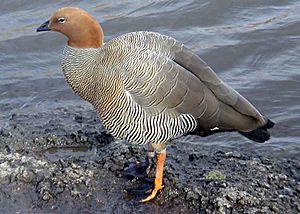Ruddy-headed goose facts for kids
Quick facts for kids Ruddy-headed goose |
|
|---|---|
 |
|
| Conservation status | |
| Scientific classification | |
| Genus: |
Chloephaga
|
| Species: |
rubidiceps
|
The ruddy-headed goose (Chloephaga rubidiceps) is a type of large sheldgoose. These birds make their homes and have their babies in the very southern parts of South America.
They like to breed on open, grassy plains in places like Tierra del Fuego and Chile. You can also find them in the Falkland Islands. Sadly, the ruddy-headed geese living in South America are now very rare.
During the colder months, these geese travel north to lowlands in southern Argentina. This is where they spend their winter. The geese in the Falkland Islands, however, stay there all year round.
Contents
What They Look Like
The ruddy-headed goose is a strong, stocky bird, about 45 to 50 centimeters (18 to 20 inches) tall. Its back is a light grey color. Its belly and chest are a rich, warm brown with black stripes.
The head and the top part of its neck are a pretty chestnut brown. Male and female geese look quite similar. Younger birds are usually a bit duller in color.
When these geese fly, you can see their black main wing feathers. The rest of their wings are white, with a wide green stripe. The male goose makes a soft whistling sound. The female goose has a louder, harsher cackle.
Where They Live and What They Eat
These geese prefer damp, open areas in forests. They mostly eat by grazing on grass, much like cows or sheep. They don't swim very often.
Outside of the time when they are raising their young, ruddy-headed geese often gather in large groups. Sometimes, they even mix with other types of geese, like the ashy-headed goose.
Life Cycle
Ruddy-headed geese build their nests among clumps of grass. They line their nests to keep the eggs safe and warm. A female goose usually lays between 4 and 11 eggs.
Why They Need Our Help
The ruddy-headed goose population in the Falkland Islands is still quite large. They live there even with competition from grazing cattle and sheep.
However, the geese living in Tierra del Fuego, South America, are in big trouble. There are only a few hundred of them left. This is because of livestock farming, but mostly due to a predator called the South American gray fox. These foxes were brought to Tierra del Fuego in the 1950s to control rabbits.
To help protect these special birds, an agreement called the Ruddy-headed Goose Memorandum of Understanding was made. It started on November 21, 2006. This agreement is part of the Convention on Migratory Species of Wild Animals (CMS).
The geese that travel between different places in South America are in great danger. Their numbers are very small, and they only live in certain areas. They face many threats where they breed in Chile and Argentina, and where they spend the winter in Argentina. The agreement aims to protect these geese, which are seriously endangered.
See also
 In Spanish: Canquén colorado para niños
In Spanish: Canquén colorado para niños


